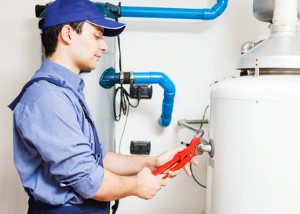At TV Plumbing, we provide water heater installation and maintenance services to residents throughout greater Los Angeles.

Our certified plumbers can help you find the highest quality water heaters and water heater parts for your home's needs. Whether you're in need of a new water heater installation, or a tune up for your current water heater model, we've got you covered.
Why Water Heaters Fail
Simply put, rusting is what makes steel water heater tanks leak and require replacement. There are a number of factors which contribute to the rusting of water heaters. Proper water heater installation, along with regular maintenance and adjustments will allow you to extend the life of your Los Angeles water heater, and hopefully save you money on expensive plumbing repairs.
Depleted Anodes: The inside of your tank is protected only as long as the anode rod has sufficient sacrificial metal remaining on its steel wire core. Inspect the rod periodically and replace it when needed. Without a functioning anode in your tank, any other measures are just wasted energy.
Electrolysis: Just as magnesium anode rods corrode (purposely) in the presence of steel, steel will rust (to the detriment of your tank) when it's near to copper or brass. The more of these metals there are, the more the steel tank will rust. Water heater connections such as hot, cold and recirculation loop lines are often made of copper or brass. When they are joined directly to the tank, excessive rusting occurs at the connections, restricting water flow and weakening the steel. Dielectric unions and plastic lined steel nipples have been developed to reduce this electrolytic corrosion.
Sediment Build-Up: Heat forces minerals to come out of solution, forming solids which settle on the bottom of your tank. This sediment is mostly calcium carbonate. The harder the water, the more sediment you can expect. When sediment accumulates in a gas heater, it forms a barrier between the water and the flame, slowing heat transfer. The subsequent overheating of the tank bottom can cause two problems. First, the glass lining starts dissolving at temperatures above 160 degrees, so over time, the steel tank bottom is gradually exposed to water and potential rusting. Second, severe overheating can weaken the metal bottom to the point of deforming under normal pressure. (Temperatures exceeding 1000 degrees have been measured at the bottom of severely scaled tanks)! Sediment causes additional problems. In both gas and electric heaters, a dense sediment layer can insulate the tank bottom from the protection of the anode rod. The sediment can also play host to bacteria. Most of these are not harmful to our health, but they make the environment in the sediment more corrosive, and the steel is under harsher attack than with heat and sediment alone.
External Environment: Don't overlook your tank's surroundings. If the air burned in a gas heater is damp or carries salt, chlorine, or other corrosive chemicals, it will attack the tank from inside the flue and combustion chamber. It may even void the warranty. Keep your heaters dry. Many tanks have failed because a plumbing fitting (either on the tank itself or overhead) leaked and rusted through the drain tank externally. Troublemakers include the drain valve, heating elements, and hot and cold connections. Even a loose packing nut on an overhead shut-off valve may leak and ruin a water heater.
 TOP RATED PLUMBER
TOP RATED PLUMBER